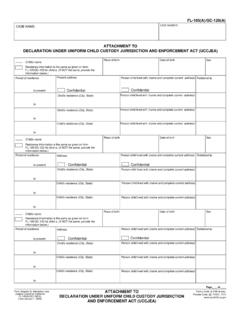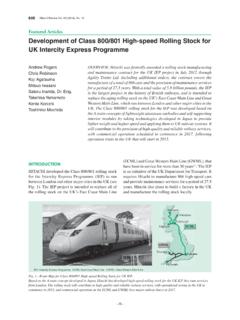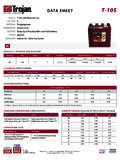Transcription of 105 - OECD.org
1 105 GUIDELINE FOR THE TESTING OF CHEMICALSA do pte d by the Co unc il o n 2 7th July 1995 Water guideline is a revised version of the original Guideline 105 which was adopted in are no differences of substance between the current version and that from 1981. Mainly theformat has been changed. The revision was based on the EC method "Water Solubility" (1).INITIAL CONSIDERATIONS2. The water solubility of a substance can be considerably affected by the presence ofimpurities. This guideline addresses the determination of the solubility in water of essentially puresubstances which are stable in water and not volatile.
2 Before determining water solubility, it is usefulto have some preliminary information on the substance, like structural formula, vapour pressure,dissociation constant and hydrolysis as a function of methods, the column elution method and the flask method which cover respectivelysolubilities below and above 10 -2 g/l are described in this guideline. A simple preliminary test is alsodescribed. It allows to determine approximately the appropriate amount of sample to be used in thefinal test, as well as the time necessary to achieve AND water solubility of a substance is the saturation mass concentration of the substance inwater at a given solubility is expressed in mass of solute per volume of solution.
3 The SI unit is kg/m3but g/l is commonly substances do not need to be employed when investigating a OF THE METHODSTest test is preferably run at 20 0,5 C. The chosen temperature should be kept constantin all relevant parts of the E/OECDP reliminary a stepwise procedure, increasing volumes of water are added at room temperature toapproximately g of the sample (solid substances must be pulverized) in a 10 ml glass-stopperedmeasuring cylinder. After each addition of an amount of water, the mixture is shaken for 10 minutesand is visually checked for any undissolved parts of the sample. If, after addition of 10 ml of water,the sample or parts of it remain undissolved, the experiment is continued in a 100 ml measuringcylinder.
4 The approximate solubility is given in Table 1 below under that volume of water in whichcomplete dissolution of the sample occurs. When the solubility is low, a long time may be requiredto dissolve a substance and at least 24 hours should be allowed. If, after 24 hours, the substance isstill not dissolved, more time (up to 96 hours) should be allowed or further dilution should beattempted to ascertain whether the column elution method or flask method should be 1ml of water g sol ubl e > 100approximate so-lubility in g/l> 10001000 to 200200 to 100100 to 50 50 to 10 10 to 1 < 1 Column elution method is based on the elution of a test substance with water from a micro-columnwhich is charged with an inert support material, previously coated with an excess of the test substance(2).
5 The water solubility is given by the mass concentration of the eluate when this has reached aplateau as a function of apparatus consists of a microcolumn (Figure 1), maintained at constant temperature. Itis connected either to a recirculating pump (Figure 2) or to a levelling vessel (Figure 3). Themicrocolumn contains an inert support held in place by a small plug of glasswool which also servesto filter out particles. Possible materials which can be employed for the support are glass beads,diatomaceous earth, or other inert microcolumn shown in figure 1 is suitable for the set-up with recirculating pump.
6 It hasa head space providing for five bed volumes (discarded at the start of the experiment) and the volumeof five samples (withdrawn for analysis during the experiment). Alternatively, the size can be reducedif water can be added to the system during the experiment to replace the initial five bed volumesremoved with impurities. The column is connected with tubing made of an inert material to therecirculating pump, capable of delivering approximately 25 ml/h. The recirculating pump can be, for example, a peristaltic or membrane pump. Care must be taken that no contamination and/or adsorptionoccurs with the tube schematic arrangement using a levelling vessel is shown in figure 3.
7 In this arrangementthe microcolumn is fitted with a one way stopcock. The connection to the levelling vessel consistsof a ground glass joint and tubing made of an inert material. The flow rate from the levelling vesselshould be approximately 25 ml/h. 2/7 OCD E/OECD105 Figure 1 Dimensions in for ground glass of glass valve forsampling3/7105 OCD E/OECDF igure 3A. Levelling vessel ( litreschemical flask)B. ColumnC. Fraction accumulatorD. ThermostatE. Teflon tubingF. Ground glass jointG. Water line (between thermostatand column, inner diameterapproximately 8 mm)Lo ading of the 600 mg of support material is transferred to a 50 ml round-bottom flask.
8 Asuitable amount of test substance is dissolved in a volatile solvent of analytical reagent quality and anappropriate amount of this solution is added to the support material. The solvent is completelyevaporated, using a rotary evaporator, as otherwise water saturation of the support will not beachieved during the elution step because of partitioning on the surface. The loaded support materialis soaked for two hours in approximately 5 ml of water and the suspension is poured into themicrocolumn. Alternatively, dry loaded support material may be poured into the water-filledmicrocolumn and two hours are allowed for loading of the support material may cause problems, leading to erroneous results, whenthe test substance is deposited as an oil.
9 These problems should be examined and the details using a recirculating flow through the column is started. It is recommended that a flow rate of approximately25 ml/h, corresponding to 10 bed volumes per hour for the column described, be used. At least thefirst five bed volumes are discarded to remove water soluble impurities. Following this, the pump isallowed to run until equilibrium is established, as defined by five successive samples whoseconcentrations do not differ by more than 30% in a random fashion. These samples should beseparated from each other by time intervals corresponding to the passage of at least ten bed on the analytical method used, it may be preferable to establish a concentration/time curveto show that equilibrium is using a levelling eluate fractions should be collected and analyzed by the chosen method.
10 Fractionsfrom the middle eluate range, where the concentrations are constant within 30% in at least fiveconsecutive fractions, are used to determine the E/OECD105 Notes applicable to both distilled water is the preferred eluent. Deionized water with a resistivity above 10megohms/cm and a total organic carbon content below can also be used. both procedures, a second run is performed at half the flow rate of the first. If the resultsof the two runs are in agreement, the test is satisfactory. If the measured solubility is higher with thelower flow rate, then the halving of the flow rate must continue until two successive runs give thesame both procedures, the fractions should be checked for the presence of colloidal matter byexamination of the Tyndall effect.















